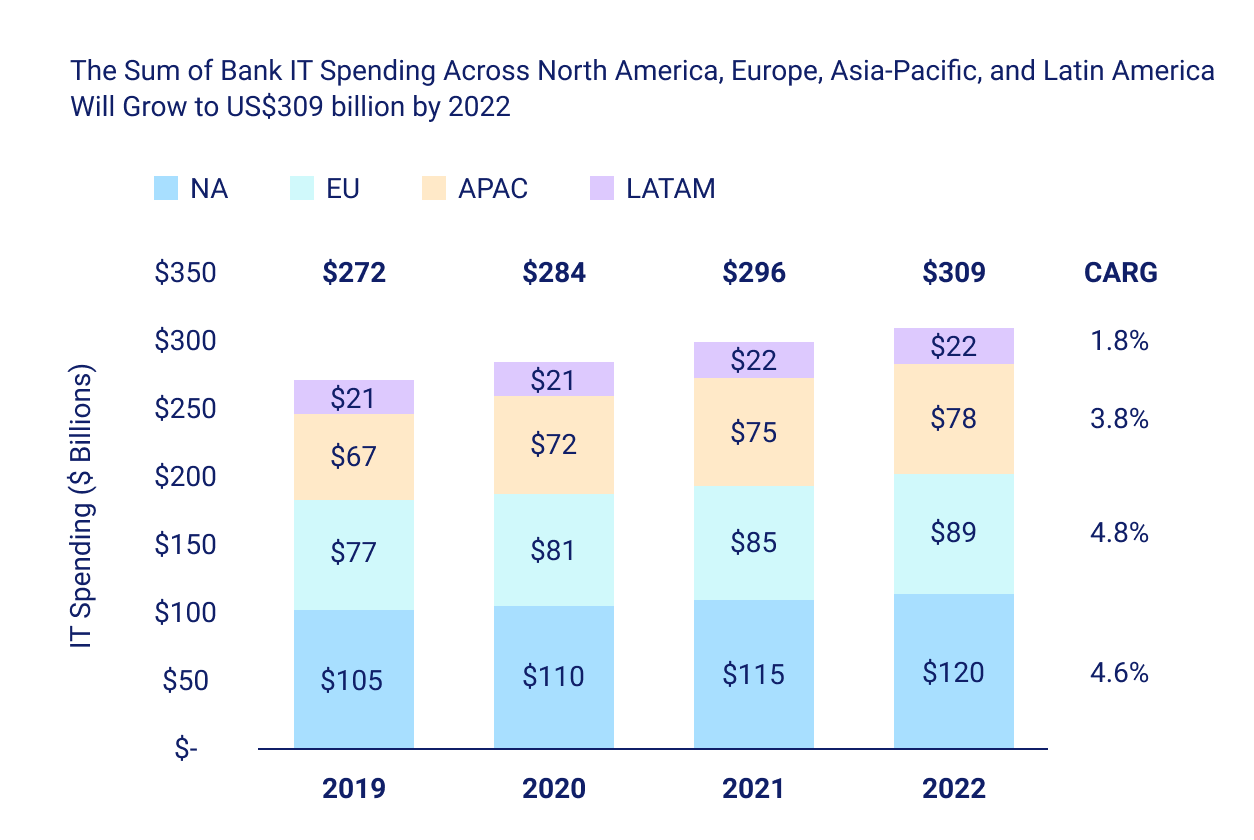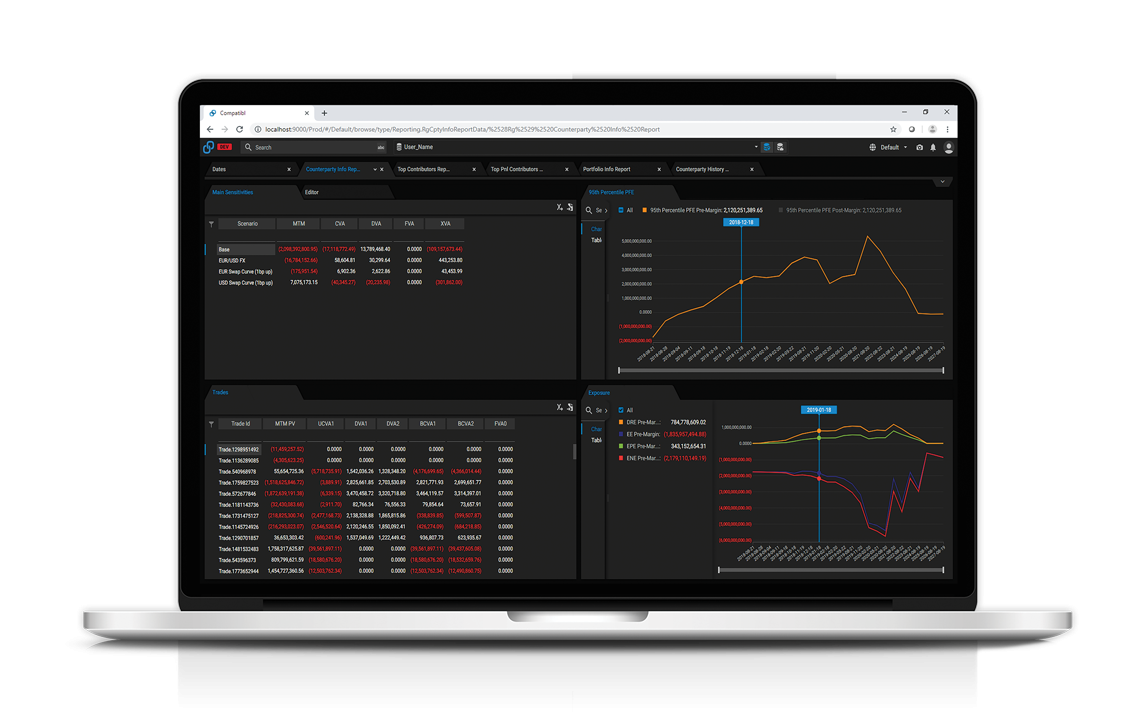As the global economy continues to recover, banks are continuing to develop new strategies to ensure they are positioned for sustainable growth. In this study, CompatibL maps out the challenges, benefits, and solutions that will be the driving factors for banking in 2022, as cloud computing steadily gains traction with banks that are looking to increase their efficiencies and reduce IT costs by moving away from their aging infrastructure.
While fintech companies are responding to the increased demand for cloud solutions, the banking industry continues to embrace cloud technologies and banking cloud software to manage the enormous amount of data the industry produces daily. With customers generating 2.5 quintillion bytes of data every day, banking and financial services spend over $67 billion on cloud services per year, with their overall IT spending growing steadily.

Source: celent.com
As the world has moved further into the digital age, business and technology are no longer separate entities. The implementation of cloud computing in banking is not only an improvement on legacy system capabilities, vastly increasing the speed of data processing, but also a way to cut infrastructure costs and to simplify configuration, security, and meet compliance challenges. However, how the cloud is to be used in the financial sector will directly affect both how these challenges are met and the benefits the cloud provides in 2022.
The Cloud in Banking, 2022: Challenges
Even though many of the threats the banking industry faced in 2021 due to COVID-19 have already been eliminated by implementing custom cloud banking solutions, some inherent challenges will remain well into 2022.






The Cloud in Banking, 2022: Benefits
More and more businesses are turning to the cloud as a way to compete and stay relevant and futureproof. Whether you are looking to transform your business, reduce costs, or become more agile, you should align your IT strategy with your business goals. As risk is an integral part of any banking business, the implementation of cloud computing in banking will help ensure that a bank maintains operational capabilities even in the most complex and fast-paced economy-driven environments.






Driven by the combined positive impact of all these benefits of cloud computing, we believe the banking industry will continue to successfully position itself as one of the growing industries in the adoption of cloud strategies and solutions in 2022.
Cloud Banking Solutions: Banks’ Cloud Strategy for 2022
The cloud now lies at the heart of the digital transformation for many industries, including banking. Overall spending on cloud computing in banking is projected to increase in 2022, with the proliferation of IT-related investments and even more financial organizations relying on cloud services provided by external vendors.
Many banking organizations have already moved to the cloud, allowing them to scale more quickly and achieve levels of agility that would not be possible with traditional on-premises IT infrastructures.
The benefits of cloud computing for banks include more effective operations, reduced IT costs, and extremely secure data. If you are considering migrating your systems or applications to the cloud, then you need an expert by your side. We are here to help you.
How CompatibL Cloud Platform Can Help you Shape Your Bank’s Cloud Strategy
We can help you determine whether cloud hosting is right for your business, and we will work with you to make a plan that fits your goals. But first, consider getting a demo of our award-winning CompatibL Cloud Platform, named best platform in 2020 and 2021.
What is CompatibL Cloud Platform?
CompatibL Cloud Platform is scalable and cost-effective open-risk banking cloud software for conducting analytics, predictive modeling, strategic planning, risk management, and enhanced BI.

For many years, CompatibL Cloud Platform has been the foundation of a cost-effective and widely available next-generation financial architecture for many financial institutions. The flexibility and customization options the CompatibL Cloud Platform provides empower any financial organization to satisfy their own unique mix of requirements.
CompatibL Cloud Platform allows seamless integration of new technologies and can be deployed in your data center or private cloud, as well as in most public clouds, including AWS and Azure. When deployed in the cloud, it leverages the latest serverless cloud technologies.

CompatibL Cloud Platform is a modern and robust cloud computing risk management tool for banking and financial institutions with traditional and serverless parallel computing, a powerful HTML5 front-end with advanced BI, the ability to integrate your analytics written in C++, C#, Java, or Python, and a back-end-agnostic database adapter for most traditional and cloud databases.
The CompatibL Cloud Platform is delivered as a customized solution and can be fully integrated with your trade, market, and reference data representation formats.
With CompatibL Cloud Platform, your data and data processing operations will always be carefully protected, since we provide one of the most secure cloud banking solutions. This level of security is achieved by using only reliable cloud technologies and strictly adhering to the established regulatory standards in banking.
*For more detailed information on cloud computing in banking, read the Cloud Adoption and Risk Report by Risk.net, supplemented with a Q&A with Siarhei Niaborski, CompatibL’s Executive Vice President of Risk, which highlights how banks benefit from using cloud technologies.



